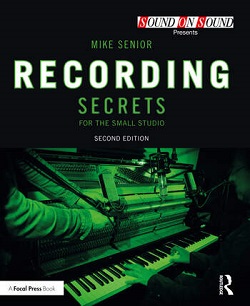Recording Secrets For The Small Studio - Additional Resources
Chapter 1: Recording A Machine
Table of Contents
(This page is for the second edition of Recording Secrets For The Small Studio. To access an archive of the first-edition resource pages, click here.)
Audio Files
(To download all WAV examples at once: 31MB ZIP)
Types Of Signal Degradation: I’ve subjected the following unmastered mix Ex01.01: WAV/MP3play_arrow to a variety of the signal degradations mentioned in Section 1.4 of the book, so you can learn what each sounds like and therefore troubleshoot your own setup problems more quickly: two types of analogue clipping distortion Ex01.02: WAV/MP3play_arrow Ex01.02: WAV/MP3play_arrow); digital clipping distortion Ex01.04: WAV/MP3play_arrow; glitching from digital-clocking or software-driver issues Ex01.05: WAV/MP3play_arrow; comb-filtering from double-monitoring Ex01.06: WAV/MP3play_arrow; and a sub-unity-gain feedback loop Ex01.07: WAV/MP3play_arrow.
Audio Impact Of Two Affordable Isolation Transformers: Anything that you put into your signal path has the potential to impact the sound, so if you’re going to use isolation transformers to interface balanced outputs with unbalanced inputs, or to avoid earth-loop problems, then it’s as well to be aware of the extent of the audible difference they might typically make. To give you an idea, here’s an unmastered mix I recorded first through a pair of TRS cables directly into my audio interface Ex01.08: WAV/MP3play_arrow, and then through the two different budget-friendly isolation transformer boxes I mentioned in the book: the ART T8 Ex01.09: WAV/MP3play_arrow and the Ebtech Hum Eliminator Ex01.10: WAV/MP3play_arrow.
Videos
- Cable-coiling Techniques: Here’s a video demonstrating my preferred version of the ‘over-under’ professional cable-coiling method, and I also explain why I actually use a different cable-coiling technique most of the time!
Links
Affordable Transformer Isolators: The two transformer isolators mentioned in the book are the ART T8 and the Morley (formerly Ebtech) Hum Eliminator. Orchid Electronics also make very affordable transformer isolators to order.
Pseudo-balanced Cables: The pseudo-balanced cable shown in the book used to be available directly from Sound On Sound magazine’s online shop, but it’s since been discontinued and I’ve been unable to find an equivalent off-the-shelf replacement. The few cables I did find that were described as ‘pseudo-balanced’ just had the cable screen disconnected at one end (which is something you can do for yourself with a standard cable and a pair of wire-cutters!), but this isn’t as good a solution as the resistor+capacitor arrangement shown in Figure 1.12 of the book.
Further Reading
Specimen Flowcharts For Assignment 1: Download specimen Assignment 1 flowcharts based on the example studio setups shown in Figures 1.9 and 1.10 of the book.
Aligning Analogue Tape Machines: There’s plenty of information about aligning tape machines to be found on the web, but here are a couple of decent resources: the Analog Rules Tape Recorder Alignment Instructions and these slightly more entry-level ‘Buying A Used tape Machine’, ‘Analogue Tape Machines’ & ‘Analogue Tape Machine Maintenance’ articles from Sound On Sound magazine.
Metering Standards & Gain Setting: If you want to know a bit more about different metering standards, check out these Sound On Sound magazine articles: ‘The Ins & Outs Of Gain Structure’; ‘Metering FAQ’; ‘The Low-down On Analogue Interfacing’; and ‘Interfacing Analogue & Digital Equipment’.
Cables & Wiring: The following Sound On Sound magazine articles provide lots of guidance about setting up the wiring scheme in a small studio: ‘Audio Cables & Wiring FAQ’; ‘Patchbays FAQ’; ‘A Practical Guide To Studio Wiring’ (part 1) & (part 2); ‘All About Studio Power & Wiring’; ‘Studio Installation Workshop’ (part 1), (part 2) & (part 3).

